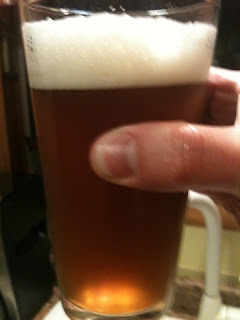My latest brew is an American Brown Ale called, "Late Summit" because I added an ounce of Summit hops late in the boil (i.e., a late hop addition). Summit hops are high alpha hops. In fact, the pellet hops I used are 17.9% alpha. Summit hops are a "super-high alpha dwarf variety grown on low trellis systems in Yakima valley" (source). They are known for having a funky, earthy, tangerine character. I'm hoping for kind dankness, tangerine, and citrus flavor.
 |
| In the Morning |
Brew Date: 2012-03-27
Recipe Name: "Late Summit" (based on Jamil's "Dirty Water Brown")
Beer Style: American Brown Ale
Batch Number: B6
Recipe Original Gravity: 1.048
Recipe Final Gravity: 1.011
Expected ABV: 4.9%
Anticipated IBUs (bitterness): 36-38
SRM (color): 20
Expected Efficiency: 70%
Calculated Brewhouse Efficiency: 73% (using 6.5 gal for wort volume)
Yeast Starter Size: 2 liter
Water Volume: 2 liters
Dry Malt Extract: 200 grams
Yeast: White Labs WLP001 California Ale Yeast
Recipe Name: "Late Summit" (based on Jamil's "Dirty Water Brown")
Beer Style: American Brown Ale
Batch Number: B6
Recipe Original Gravity: 1.048
Recipe Final Gravity: 1.011
Expected ABV: 4.9%
Anticipated IBUs (bitterness): 36-38
SRM (color): 20
Expected Efficiency: 70%
Calculated Brewhouse Efficiency: 73% (using 6.5 gal for wort volume)
Yeast Starter Size: 2 liter
Water Volume: 2 liters
Dry Malt Extract: 200 grams
Yeast: White Labs WLP001 California Ale Yeast
Grain Bill
10 lb Canadian Two-Row
.5 lb Crystal 40L
.5 lb Chocolate Malt
.75 lb Crystal 60L
.75 lb Victory
10 lb Canadian Two-Row
.5 lb Crystal 40L
.5 lb Chocolate Malt
.75 lb Crystal 60L
.75 lb Victory
 |
| Everything but the Kitchen Sink |
Music: Grateful Dead - Dick's Picks 14 - Boston Music Hall, 1973-11-30 & 1973-12-02
All the water used for this beer is straight from our tap. We have well water and the pH is between 6.5 and 7. My understanding is that the darker malt will bring the pH down toward the 5.2 range, which is ideal.
All the water used for this beer is straight from our tap. We have well water and the pH is between 6.5 and 7. My understanding is that the darker malt will bring the pH down toward the 5.2 range, which is ideal.
Mash
Strike Water Volume: 4 gal
Strike Water Temperature: 165 F
Rest Temperature: 152 F
Rest Time: 60 min
Strike Water Volume: 4 gal
Strike Water Temperature: 165 F
Rest Temperature: 152 F
Rest Time: 60 min
 |
| Brown Vorlauf |
Sparge #1
Sparge Water Volume: 2.5 gal
Rest Temperature: 170 F
Rest Time: 5 min
Sparge #2
Sparge Water Volume: 2 gal
Rest Temperature: 170 F
Rest Time: 5 min
Pre-Boil Gravity: 1.044
Pre-Boil Volume: ~ 6.5 gal
Boil Time: 60 min
Sparge Water Volume: 2.5 gal
Rest Temperature: 170 F
Rest Time: 5 min
Sparge #2
Sparge Water Volume: 2 gal
Rest Temperature: 170 F
Rest Time: 5 min
Pre-Boil Gravity: 1.044
Pre-Boil Volume: ~ 6.5 gal
Boil Time: 60 min
 |
| Rolling Boil |
Hop Additions
10 grams Horizon @ 60 min
1 oz Amarillo @ 15 min
1 oz Summit @ 5 min
1 oz Amarillo @ 15 min
1 oz Summit @ 5 min
 |
| Yeast Starter and Hops |
Actual Original Gravity: 1.050
Brew Day End Time: 7:32 PM
Fermentation Temperature: 64 F
 |
| It's taking off! Thursday night (29th) |











